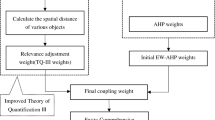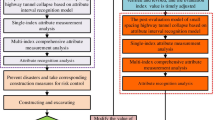Abstract
Collapse is a major geological disaster that occurs during mountain tunnel construction. However, the accuracy of collapse risk assessment is generally restricted by evaluation factors or methods. This paper proposes a novel integrated collapse risk evaluation method for mountain tunnels based on case-based reasoning, rough set theory, and unascertained measure-set pair analysis (UM-SPA) theory. First, the risk surroundings and risk factors involved in tunnel collapse are summarized by the analytic hierarchy process, and a preliminary risk evaluation index system is established. Then, an attribute reduction algorithm based on the conditional information entropy of a rough set is proposed and applied to cases with similar attribute characteristics as those of the tunnel to be evaluated, to remove the relatively insignificant or redundant indices and improve the reliability of risk assessment. Finally, taking the relationship between tunnel collapse and its evaluation indices as an unascertained system, Set Pair Analysis (SPA) theory is introduced to optimize the credible degree recognition criteria of unascertained measure theory (UMT). Combined with the modified entropy weight method, a UM-SPA model for tunnel collapse risk evaluation is established to calculate the level of collapse risk quantitatively and predict the development trend of risk dynamically. Taking Xiucun Tunnel passing through fault F18 as an example, collapse risk is evaluated and compared with the evaluation results of traditional UMT and field status. The results demonstrate the feasibility and efficiency of the proposed approach and provide a new idea for collapse risk prediction while constructing mountain tunnels.
Similar content being viewed by others

References
Alimoradi A, Moradzadeh A, Naderi R, Salehi MZ, Etemadi A (2008) Prediction of geological hazardous zones in front of a tunnel face using TSP-203 and artificial neural networks. Tunnelling and Underground Space Technology 23(6):711–717, DOI: https://doi.org/10.1016/j.tust.2008.01.001
Boubou R, Emeriault F, Kastner R (2010) Artificial neural network application for the prediction of ground surface movements induced by shield tunnelling. Canadian Geotechnical Journal 47(11):1214–1233, DOI: https://doi.org/10.1139/T10-023
Chen XX, Chen RH, Lin K, Zhang MW (2015) Application of the improved analytic hierarchy process in the risk management of tunnel construction. Applied Mechanics and Materials 696:295–300, DOI: https://doi.org/10.4028/www.scientific.net/AMM.696.295
Chen W, Wang H, Zhang GH, Wang CT, Zhong GQ (2020) Evaluation of tunnel collapse susceptibility based on T-S fuzzy fault tree and Bayesian network. Journal of Shanghai Jiaotong University 54(08):820–830, DOI: https://doi.org/10.16183/j.cnki.jsjtu.2020.99.011 (in Chinese)
Chen W, Zhang GH, Wang H, Chen LB (2019a) Risk assessment of mountain tunnel collapse based on rough set and conditional information entropy. Rock and Soil Mechanics 40(09):3549–3558, DOI: https://doi.org/10.16285/j.rsm.2018.1290 (in Chinese)
Chen W, Zhang GH, Wang H, Zhong GQ, Wang CT (2019b) Evaluation of possibility of tunnel collapse by drilling and blasting method based on T-S fuzzy fault tree. Rock and Soil Mechanics 40(S1):319–328, DOI: https://doi.org/10.16285/j.rsm.2018.1712 (in Chinese)
Chen JJ, Zhou F, Yang JS, Liu BG (2009) Fuzzy analytic hierarchy process for risk evaluation of collapse during construction of mountain tunnel. Rock and Soil Mechanics 30(8):2365–2370, DOI: https://doi.org/10.16285/j.rsm.2009.08.017 (in Chinese)
Dikmen I, Birgonul MT (2006) An analytic hierarchy process based model for risk and opportunity assessment of international construction projects. Canadian Journal of Civil Engineering 33(1):58–68, DOI: https://doi.org/10.1139/105-087
Eskesen S, Tengborg P, Kampmann J, Holst Veicherts T, Veicherts T (2004) Guidelines for tunnelling risk management: International tunnelling association, working group No. 2. Tunnelling and Underground Space Technology 19(3):217–237, DOI: https://doi.org/10.1016/j.tust.2004.01.001
Ferdous R, Khan F, Sadiq R, Amyotte P, Veitch B (2012) Handling and updating uncertain information in bow-tie analysis. Journal of Loss Prevention in the Process Industries 25(1):8–19, DOI: https://doi.org/10.1016/j.jlp.2011.06.018
Hallowell MR, Gambatese JA (2010) Qualitative research: Application of the Delphi method to CEM research. Journal of Construction Engineering and Management 136(1):99–107, DOI: https://doi.org/10.1061/(ASCE)CO.1943-7862.0000137
He ML, Liu J, Liu L, Zhou J (2012) Unascertained measure model of assessment tunnel collapse risk and its application in engineering. Journal of Central South University (Science and Technology) 43(9):346–352 (in Chinese)
Hong ES, Lee IM, Shin HS, Nam SW, Kong JS (2009) Quantitative risk evaluation based on event tree analysis technique: Application to the design of shield TBM. Tunnelling and Underground Space Technology 24(3):269–277, DOI: https://doi.org/10.1016/j.tust.2008.09.004
Hyun KC, Min S, Choi H, Park J, Lee IM (2015) Risk analysis using fault-tree analysis (FTA) and analytic hierarchy process (AHP) applicable to shield TBM tunnels. Tunnelling and Underground Space Technology 49:121–129, DOI: https://doi.org/10.1016/j.tust.2015.04.007
Jia QJ, Wu L, Li B, Chen CH, Peng YX (2019) The comprehensive prediction model of rockburst tendency in tunnel based on optimized unascertained measure theory. Geotechnical and Geological Engineering 37(4):3399–3411, DOI: https://doi.org/10.1007/s10706-019-00854-9
Khakzad N, Khan F, Amyotte P (2011) Safety analysis in process facilities: Comparison of fault tree and Bayesian network approaches. Reliability Engineering & System Safety 96(8):925–932, DOI: https://doi.org/10.1016/j.ress.2011.03.012
Li ZH, Huang HW, Xue YD (2014) Cut-slope versus shallow tunnel: Risk-based decision making framework for alternative selection. Engineering Geology 176:11–23, DOI: https://doi.org/10.1016/j.enggeo.2014.04.001
Li X, Li XB, Su YH (2016) A hybrid approach combining uniform design and support vector machine to probabilistic tunnel stability assessment. Structural Safety 61:22–42, DOI: https://doi.org/10.1016/j.strusafe.2016.03.001
Li JX, Wang CM, Wang GC (2013) Landslide risk assessment based on combination weighting-unascertained measure theory. Rock and Soil Mechanics 34(02):468–474, DOI: https://doi.org/10.16285/j.rsm.2013.02.022 (in Chinese)
Li SC, Wu J, Xu ZH, Li LP (2017) Unascertained measure model of water and mud inrush risk evaluation in karst tunnels and its engineering application. KSCE Journal of Civil Engineering 21(5):1170–1182, DOI: https://doi.org/10.1007/s12205-016-1569-z
Olson DL, Delen D (2008) Advanced data mining techniques. Springer-Verlag, Berlin, Heidelberg, Germany, 1–182
Pawlak Z (1982) Rough sets. International Journal of Computer and Information Sciences 11(5):341–356, DOI: https://doi.org/10.1007/BF01001956
Railway Construction (2007) No.200. Railway tunnel risk evaluation and management interim provisions. The Professional Standard of People’s Republic of China, Beijing, China (in Chinese)
Sadeghi N, Fayek AR, Pedrycz W (2010) Fuzzy Monte Carlo simulation and risk assessment in construction. Computer-Aided Civil and Infrastructure Engineering 25(4):238–252, DOI: https://doi.org/10.1111/j.1467-8667.2009.00632.x
Sagong M, Lee JS, Chun BS, Choi JK (2006) Induction of tunnel reinforcement selection rules by using decision tree technique. Tunnelling and Underground Space Technology 21(3):389–389, DOI: https://doi.org/10.1016/j.tust.2005.12.200
Schubert M, Htoj NP, Ragnoy A, Buvik H (2012) Risk assessment of road tunnels using Bayesian networks. Procedia-Social and Behavioral Sciences 48:2697–2706, DOI: https://doi.org/10.1016/j.sbspro.2012.06.1239
Shin HS, Kwon YC, Jung YS, Bae GJ, Kim YG (2009) Methodology for quantitative hazard assessment for tunnel collapses based on case histories in Korea. International Journal of Rock Mechanics and Mining Sciences 46(6):1072–1087, DOI: https://doi.org/10.1016/j.ijrmms.2009.02.009
Sousa RL, Einstein HH (2012) Risk analysis during tunnel construction using Bayesian networks: Porto Metro case study. Tunnelling and Underground Space Technology 27(1):86–100, DOI: https://doi.org/10.1016/j.tust.2011.07.003
Sun JL, Liu BG, Chu ZF, Chen L, Li X (2018) Tunnel collapse risk assessment based on multistate fuzzy Bayesian networks. Quality and Reliability Engineering International 34(8):1646–1662, DOI: https://doi.org/10.1002/qre.2351
Sun L, Xu JC, Cao XZ (2009) Decision table reduction method based on new conditional entropy for rough set theory. 2009 international workshop on intelligent systems and applications, May 23–24, Wuhan, China (in Chinese)
Tan C, Song Y, Che H (2017) Application of set pair analysis method on occupational hazard of coal mining. Safety Science 92:10–16, DOI: https://doi.org/10.1016/j.ssci.2016.09.005
Wang GY (1990) Unascertained information and its mathematical treatment. Journal of Harbin University of Civil Engineering and Architecture 23(4):1–8 (in Chinese)
Wang YC, Jing HW, Yu LY, Su HJ, Luo N (2017) Set pair analysis for risk assessment of water inrush in karst tunnels. Bulletin of Engineering Geology and the Environment 76(3):1199–1207, DOI: https://doi.org/10.1007/s10064-016-0918-y
Wu Q, Zhao DK, Wang Y, Shen JJ, Mu WP, Liu HL (2017) Method for assessing coal-floor water-inrush risk based on the variable-weight model and unascertained measure theory. Hydrogeology Journal 25(7):2089–2103, DOI: https://doi.org/10.1007/s10040-017-1614-0
Xu ZS, He ZJ, Song P (2009) The application of risk management to investment of the railway tunnel project. First international conference on information science and engineering, December 26–28, Nanjing, China (in Chinese)
Xue YG, Li ZQ, Li SC, Qiu DH, Tao YF, Wang L, Yang WM, Zhang K (2019) Prediction of rock burst in underground caverns based on rough set and extensible comprehensive evaluation. Bulletin of Engineering Geology and the Environment 78(1):417–429, DOI: https://doi.org/10.1007/s10064-017-1117-1
Zhao KQ (1994) Set pair analysis and its preliminary application. Discovery of Nature 13(1):67–72 (in Chinese)
Zhang P, Chen JP, Qiu DH (2009) Evaluation of tunnel surrounding rock quality with extenics based on rough set. Rock and Soil Mechanics 30(1):246–250, DOI: https://doi.org/10.16285/j.rsm.2009.01.012 (in Chinese)
Zhang LW, Zhang DY, Li SC, Qiu DH (2012) Application of RBF neural network to rockburst prediction based on rough set theory. Rock and Soil Mechanics 33(S1):270–276, DOI: https://doi.org/10.16285/j.rsm.2012.s1.008 (in Chinese)
Zhou J, Li XB (2012) Integrating unascertained measurement and information entropy theory to assess blastability of rock mass. Journal of Central South University 19(7):1953–1960, DOI: https://doi.org/10.1007/s11771-012-1231-y
Zou Q, Zhou JZ, Zhou C, Song LX, Guo J (2013) Comprehensive flood risk assessment based on set pair analysis-variable fuzzy sets model and fuzzy AHP. Stochastic Environmental Research and Risk Assessment 27(2):525–546, DOI: https://doi.org/10.1007/s00477-012-0598-5
Zhang GH, Chen W, Jiao YY, Wang H, Wang CT (2020) A failure probability evaluation method for collapse of drill-and-blast tunnels based on multistate fuzzy Bayesian network. Engineering Geology 276, DOI: https://doi.org/10.1016/j.enggeo.2020.105752 (in press)
Zhang GH, Jiao YY, Chen LB, Wang H, Li SC (2016a) An analytical model for assessing the collapse risk during mountain tunnel construction. Canadian Geotechnical Journal 53(2):326–342, DOI: https://doi.org/10.1139/cgj-2015-0064
Zhang LM, Wu XQ Qin YW, Skibniewski MJ, Liu WL (2016b) Towards a fuzzy Bayesian network based approach for safety risk analysis of tunnel-induced pipeline damage. Risk Analysis 36(2):278–301, DOI: https://doi.org/10.1111/risa.12448
Zhang LM, Wu XQ Skibniewski MJ, Zhong JB, Lu YJ (2014) Bayesian-network-based safety risk analysis in construction projects. Reliability Engineering & System Safety 131:29–39, DOI: https://doi.org/10.1016/j.ress.2014.06.006
Acknowledgments
This research was sponsored by the National Key R&D Program of China (2017YFC1501304) and China National Natural Science Foundation (41731284, 51579235, 41172287).
Author information
Authors and Affiliations
Corresponding author
Rights and permissions
About this article
Cite this article
Chen, W., Zhang, G., Jiao, Y. et al. Unascertained Measure-Set Pair Analysis Model of Collapse Risk Evaluation in Mountain Tunnels and Its Engineering Application. KSCE J Civ Eng 25, 451–467 (2021). https://doi.org/10.1007/s12205-020-0627-8
Received:
Revised:
Accepted:
Published:
Issue Date:
DOI: https://doi.org/10.1007/s12205-020-0627-8



